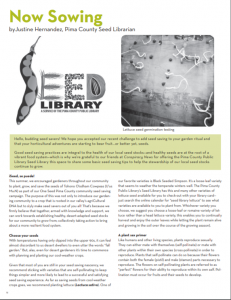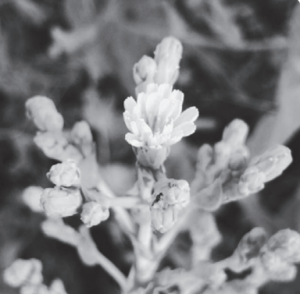 This article originally appeared in Conspiracy News, Fall 2017, Cooperating for Change Edition, p. 12.
This article originally appeared in Conspiracy News, Fall 2017, Cooperating for Change Edition, p. 12.
¡Seed, se puede!
This summer, we encouraged gardeners throughout our community to plant, grow, and save the seeds of Toho
no O’odham Cowpeas (U’us Mu:N) as part of our One Seed Pima County community seed saving campaign. The purpose of this was not only to introduce our gardening community to a crop that is rooted in our valley’s agriCultural DNA but to slyly make seed savers out of you all! That’s because we firmly believe that together, armed with knowledge and support, we can work towards establishing healthy, desert-adapted seed stocks for our community to grow from; collectively taking action to bring about a more resilient food system.
Sow pick out your seeds and together let’s continue the work of community-supported seeds!
Choose your seeds
With temperatures having only dipped into the upper 90s, it can feel almost discordant to us desert dwellers to even utter the words “fall garden.” But, alas, even for desert gardeners it’s time to commence with planning and planting our cool-weather crops.
Given that most of you are still in your seed saving nascency, we recommend sticking with varieties that are self-pollinating to keep things simpler and more likely to lead to a successful and satisfying seed saving experience. As far as saving seeds from cool-weather crops goes, we recommend planting lettuce (Lactuca sativa). One of our favorite varieties is Black Seeded Simpson. It’s a loose-leaf variety that seems to weather the temperate winters well. The Pima County Public Library’s Seed Library has this and many other varieties of lettuce seed available for you to check-out with your library card--just search the online calendar for “seed library lettuce” to see what varieties are available to you to plant from. Whichever variety you choose, we suggest you choose a loose-leaf or romaine variety of lettuce rather than a head lettuce variety, this enables you to continually harvest and enjoy the outer leaves while letting the plant remain alive and growing in the soil over the course of the growing season.
A plant sex primer
Like humans and other living species, plants reproduce sexually. They can either mate with themselves (self-pollinate) or mate with other plants within their own species (cross-pollinate) in order to reproduce. Plants that self-pollinate can do so because their flowers contain both the female (pistil) and male (stamen) parts necessary to reproduce. The flowers on self-pollinating plants are referred to as “perfect” flowers for their ability to reproduce within its own self. Pollination must occur for fruits and their seeds to develop.
Self-pollinating crops like lettuces are a good place to start for novice seed savers because they almost always reliably produce seeds that are “true to type” without having to take too many precautions to prevent cross-pollination with other varieties of the same species you may be growing in your garden (see June 2017 Conspiracy News Now Sowing for a botany refresher). That said, we always err on the side of extra precaution when planting multiple varieties of any self-pollinating crops and will keep different varieties of that species--in this case, lettuce--separated by buffer crops of an altogether different species such as radishes or carrots (both companion plants to lettuce).
Grow
Sow lettuce seed in well-fertilized soil. Like all leafy greens, lettuce craves nitrogen to help it achieve its signature verdant hue. Peas, another cool-weather crop, can be planted alongside lettuce to help fix the nitrogen in the soil. Otherwise, composted manures or fish emulsion are good, organic ways to add nitrogen to the soil.
You can continue to sow lettuce seed throughout the growing season--October through November and January through February--to ensure a steady supply of lettuce for your table.
Healthy plants equal healthy seeds
Healthy, happy, and hardy plants generally produce healthy seed. When we turn our garden ambitions toward seed saving--especially for the purpose of sharing with others--we are making a pledge to only contribute seeds that we believe to be from our healthiest, tastiest plants and free of disease to the best of our knowledge.
Tip: Germination testing is a good practice to get in the habit of as a seed saver. Simple germination tests enable a seed saver to determine if the seed they’ve saved and collected is viable. There are many resources in the library and online that can show you how to do a germination test. One of my favorite sources of info on this is on the Southern Exposure Seed Exchange website.
Harvesting seeds
One lettuce plant will potentially produce hundreds of seeds, so it’s really only necessary to allow a few of your lettuce plants to “go to seed.” Basically, letting them mature past the point when their leaves are tender and just right for eating, allowing them to bolt. As the days grow warmer lettuce will bolt. Bolting is basically a plant’s attempt to reproduce itself before it dies. In the case of lettuce, it will send up a thin flower stock from its center. The flowers that form on tiny branches along the stock will then mature over time into the fruit bearing seeds of the lettuce. As your plants start to show signs of bolting, thin your remaining lettuce plants leaving 15 inches between plants to you have decided to allow to “go to seed.” Ideally, you want to collect seeds from plants that bolt later so as not to select for early bolting.
Some harvesting of the outer leaves can be tolerated on the plants that you intend to save seed from without affecting seed production. So as best as you can, know ahead of time which plants you plan to allow to go to seed. These may be plants that were sown during a later-season reseeding.
You can hand-pick seeds as they mature along the flower stock (they’re the things that look like spiky seeds nestled in puffs of white fluff). Or you can you can put a cinched mesh bag (pollination bags work great) around the maturing stock to prevent loss of seeds due to wind or hungry birds. When stalks are completely dry, cut and thresh over a sheet. Sieve seeds and leave on newspaper to dry for a few weeks. Store completely dry seeds in clearly labeled envelopes, baggies, or jars kept in a cool, dark, and dry space. Consider sharing a portion of your harvest with other gardeners and with the Seed Library.
Plant geek
What we know as a lettuce seed is actually an indehiscent fruit (a dry fruit that doesn’t split open to reveal or release its seed) referred to as an achene. The actual lettuce seed remains hidden within the fruit. What we are planting when we plant lettuce is the seed within the fruit. Sunflower seeds are another example of an achene.
Seed saver’s toolkit:
- Garden journal to help her remember what she planted, where she planted, and when she planted
- Pollination bags to prevent unwanted plant sex (aka cross-pollination). These can be hand-sewn from mesh-like fabric scraps found at the fabric store, but you can also find them at Native Seeds/SEARCH or online.
- Seed screens, mesh colanders, bowls, and wind for separating plant matter (chaff) from the seeds (the library has an array of different sized screens for you to borrow)
- Seed saving resources (the library has many wonderful and easy to follow seed saving books for you to check-out)
- Curiosity and patience
Dig deeper
Check-out the library’s calendar of events for gardening, seed saving, and community engagement programs offered in our libraries. We work with many of our community’s conservation and gardening organizations, including Native Seeds/SEARCH and Pima County Master Gardeners, as well as local gardeners like Brandon Merchant and Jacqueline Soule, to help our community grow. Or learn more from borrow from the many books, magazines, and videos available to you through the library. Some of our favorites:




